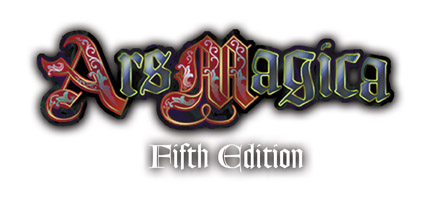Languages of Mythic Europe
| Ars Magica Primer | |
|---|---|
 | |
| Game Setting | |
| Mythic Europe | |
| The Order of Hermes | |
|
The Order of Hermes The Code of Hermes The Peripheral Code Hermetic Book Cycle |
Back to Mythic Europe
Introduction
These are the languages and rules defined for Mythic Europe for Simon Cornelius’ Ars Magica game. It is based on Guardians of the Forest and The Lion and the Lily but expanded in scope and with the penalties between languages reduced by 1 (e.g. Langue d'Oc and Northern French are -1 for different dialects). from that. These rules greatly simplify our understanding of the historical situation at the time, for the purposes of game-play.
Language Groups
The main division of languages is into Language Groups. Any speaker of one member of a Group can converse with a speaker of another, but with a penalty determined by the penalty in title of the first common cell in the relevant language table. So, for example, for a speaker of Irish Gaelic to converse with a speaker of Southern Welsh, the penalty is -2. This may never take the score below 1 though.
Dialect
One of the main simplifications is to treat all dialects as the same language. Persons with little exposure to society outside their own locality will have a dialect as their speciality. Educated and well-travelled speakers do not have dialect: instead, they may have other specialities.
Two speakers of the same language but both with different dialects still converse at the same level of ability but the communication will be slightly slower (rarely relevant in the game).
Language Tables
Celtic Languages
| Language Group (-2) | Sub-Groups (-1) | Languages | Dialects |
| Celtic Languages | Goidelic (Gaelic) | Irish Gaelic | Leinster, Munster, Ulster, Connaught |
| Scots Gaelic | East Highlands, West Highlands and Islands | ||
| Manx Gaelic | Manx | ||
| Brythonic | Breton | East Breton, West Breton | |
| Cornish | Cornish | ||
| Cumbrian | Cumbrian | ||
| Northern Welsh | Northern Welsh | ||
| Southern Welsh | Southern Welsh |
Germanic Languages
| Language Group (-2) | Sub-Groups (-1) | Languages | Dialects |
| Germanic | Anglo-Frisian Group | Lowland Scots | Lowland Scots |
| Northern English | Mercian, Northumbrian | ||
| Southern English | Wessex, Sussex, Anglia, Kent | ||
| Frisian | Frisian | ||
| German Group | Low German | Flemish, Holland, Brabant , Westphalian, Emsland, Bremenasch, Holstein, Oldenburg, Mecklenburg, Brandenburg, Pommern | |
| Middle German | Thuringian, Mittelfränkisch, Hessian, Upper Saxon, Silesian German, Lusatian German | ||
| High German | Alsatian, Bavarian, Bohemian, Carinthian, Franconian, Luxemburgish, Styrian, Swabian, Swiss German, Tyrolian, Yiddish | ||
| Norse | Icelandic | Icelandic | |
| Norwegian | Southern Norwegian | ||
| Faeroese | Faeroese | ||
| Danish | Danish | ||
| Eastern Norse | Swedish, Scanian, Gotlandish |
Romance (Latinate) Languages
| Language Group (-2) | Sub-Groups (-1) | Languages | Dialects |
| Romance Languages | French Languages | Northern French (Langues d'oïl) |
Francien (Orléans, Bourbonnais, Champagne, Paris) |
| Picard (Picardy, Lorraine, Franc-Comtois) | |||
| Norman (Normandy, eastern Brittany, Maine) | |||
| Poitevin (Poitou, Saintonge, Anjou) | |||
| Bourguignon (Burgundy) | |||
| Walloon (Flanders, Brabant) | |||
| Langues d’Oc | Languedocien (Toulouse) | ||
| Provençal (Arles, Avignon, Nîmes, Provencal Maritime, Nice) | |||
| Gascon (Guyenne) | |||
| Occitan (Limousin, Auvergnat Provençal Alpine) | |||
| Iberian Languages | Catalan | Catalan (Catalonia) | |
| Portuguese | Portuguese (Portugal) | ||
| Aragonese | Aragonese (Aragon, Navarre) | ||
| Castilian | Castilian (Castile) | ||
| Italian Languages | Gallo-Italian | Piedmontese, Lombard, Emiliano-Romagnolo, Ligurian, Venetian | |
| Italo-Dalmatian | Tuscan, Sicilian, Neapolitan, Corsican | ||
| Sardinian | Sardinian | ||
| Eastern Romance | Dalmatian | Dalmatian (Dalmatia) | |
| Romanian | Romanian (Romania) |
Greco-Armemian
| Language Group (-2) | Sub-Groups (-1) | Languages | Dialects |
| Greco-Armemian | Greek | "Standard" (Constantinopolitan), Cypriot, Cretan, Cappodocian | |
| Armenian | Armenia, Cicilian | ||
Finno-Ugric Languages
| Language Group (-2) | Sub-Groups (-1) | Languages | Dialects |
| Finno-Ugric | Ugric | Hungarian | Western, Eastern, Csango |
| Finno-Lappic | Estonian | Estonian | |
| Livonian | Livonian | ||
| Finnish | Finnish, Karelian | ||
| Sammi | Western, Eastern |
Other Languages
- Albanian: Gheg dialect is spoken in the north; Tosk dialect, the south.
- Arabic: Spoken through most of the Islamic world. Local languages also exist.
- Armenian: Classical Armenian (Grabar) uses the 38-letter alphabet developed by St. Mesrop. Spoken in Kingdom of Lesser Armenia and in some areas through Anatolia and the Caucasus.
- Basque: spoken in the western Pyrenees.
- Berber: spoken in Moorish Spain and Northern Africa.
- Caucasian languages: A wide variety of languages are spoken in the Caucasian mountains, with only a passing similarity to each other. They are not Indo-European languages.
- Finnish: Major dialects include Estonian, Sami (northern Norway and Sweden), and Suomi (in Finland).
- Greek: The official language of the Byzantine Empire.
- Magyar: spoken in the middle Danube basin (Hungary).
- Maltese: spoken on Malta, oddly enough.
- Persian (a.k.a. Farsi): One of the more prominent languages of the Islamic world.